Prediction of Water Quality Index of Island Counties Under River Length System—A Case Study of Yuhuan City
Abstract
1. Introduction
2. Materials and Methods
2.1. Data Sources
2.2. Construction of Machine Learning Models
2.2.1. Multiple Linear Regression
2.2.2. Regression Decision Tree (DT)
2.2.3. Support Vector Regression (SVR)
2.2.4. Random Forest (RF)
2.2.5. Extreme Gradient Boost (XGBoost)
2.3. Model Evaluation Indicators
2.4. Variable Contribution Assessment
3. Results
3.1. Health Status of Water Quality
3.2. Exploration into the Correlation of Water Quality Related Factors
3.3. Construction and Evaluation of Machine Learning Models
3.4. Exploration of the Contribution of Water Quality-Related Factors
4. Analysis and Suggestions on Governance Measures
4.1. Strengthen Agricultural-Related Governance
4.2. Strengthen the Governance of Key Pollution Factors
4.3. Promote the Digital Transformation of Water Quality Management
4.4. Enhancing Public Awareness and Institutional Support
5. Conclusions
- Machine learning algorithms perform well in predicting water quality indices. This study found that various machine learning algorithms have shown good performance in predicting water quality indices. As the number of significantly correlated variables in the input variables increases, the predictive performance of the model shows an upward trend. Under the optimal input variable scheme, XGBoost demonstrated the best predictive ability, with RMSE, MAE, and Adj.R2 metrics superior to other algorithms. This result indicates that machine learning algorithms have broad application prospects in predicting water quality indices and can provide scientific basis and technical support for water quality management work.
- Ensemble learning algorithms have demonstrated exceptional performance in water quality prediction, particularly in handling complex water quality data and improving prediction accuracy and stability. This study highlights that algorithms such as random forest and extreme gradient boosting are particularly effective in this domain, likely due to their ability to construct strong learners by combining multiple weak learners, thereby capturing more intricate data features and patterns. Given these advantages, ensemble learning algorithms should be prioritized in future water quality prediction research. Furthermore, this study identifies TP, NH3-N, and CODCr as critical factors influencing the CWQI. Through SHAP analysis, it is evident that the concentrations of these parameters significantly impact water quality predictions in Yuhuan City, underscoring the importance of nitrogen and phosphorus pollution as key determinants of water environment quality. Consequently, effective water quality management strategies must prioritize the prevention and control of nitrogen and phosphorus pollution, through measures such as agricultural non-point source pollution control, industrial pollution source supervision, and urban sewage treatment plant operation management, to reduce pollution loads and enhance water environment quality. Additionally, the water quality prediction model developed in this study provides a robust scientific basis and technical support for water quality management. By analyzing relevant water quality parameters, the model enables the prediction of future trends in water quality index changes, offering valuable early warning and decision-making support for water quality management. Moreover, the model facilitates the evaluation of different governance measures, enabling the optimization of management plans and the enhancement of governance efficiency. The application of such models in water quality management holds significant practical significance and application value, underscoring their importance in advancing sustainable water resource management.
- Future research directions and prospects. Although this study has achieved some meaningful results in predicting water quality indices, there are still some shortcomings and issues that need further research. For example, the data sample size used in this study is relatively small and may not fully reflect the water quality status of Yuhuan City. Meanwhile, this study only considered some water quality parameters as input variables, which may have overlooked other factors that have a significant impact on water quality. Therefore, in future research, measures such as expanding the data sample size and increasing the number of input variables can be considered to improve the predictive accuracy and generalization ability of the model. In addition, the application effects of other machine learning algorithms in water quality prediction and the potential of advanced technologies such as hybrid models and deep learning in water quality prediction can also be explored. Through these efforts, the research and application of water quality prediction models can be further improved, providing more scientific, accurate, and effective support for water quality management.
Author Contributions
Funding
Institutional Review Board Statement
Informed Consent Statement
Data Availability Statement
Acknowledgments
Conflicts of Interest
Appendix A
| XGBoost | 1 | 2 | 3 | 4 | 5 | 6 | 7 | 8 | 9 | 10 | Mean | SD |
|---|---|---|---|---|---|---|---|---|---|---|---|---|
| RMSE | 0.87 | 1.02 | 0.58 | 0.50 | 0.34 | 0.66 | 0.38 | 1.08 | 0.66 | 0.87 | 0.70 | 0.24 |
| MAE | 0.65 | 0.62 | 0.49 | 0.41 | 0.28 | 0.55 | 0.32 | 0.70 | 0.54 | 0.65 | 0.52 | 0.13 |
| Adj.R2 | 0.58 | 0.50 | 0.65 | 0.68 | 0.87 | 0.64 | 0.79 | 0.62 | 0.67 | 0.58 | 0.66 | 0.10 |
| DO/CODMn/BOD/NH3-N/CODCR/TP | I | II | III | IV | V |
|---|---|---|---|---|---|
| 2020 | 9/0/5/0/1/1 | 36/4/5/10/1/12 | 5/23/18/19/14/25 | 3/26/30/18/38/8 | 0/0/0/8/0/7 |
| 2021 | 28/0/6/0/5/1 | 12/6/6/21/5/11 | 11/33/25/20/35/30 | 3/15/23/12/14/11 | 0/0/0/1/0/1 |
| 2022 | 20/0/9/3/7/1 | 11/8/9/13/7/14 | 3/26/13/15/24/17 | 5/5/16/8/8/7 | 0/0/1/0/0/0 |
| 2023 | 33/0/22/1/9/0 | 18/13/22/21/29/10 | 8/33/14/18/29/30 | 2/5/9/10/12/11 | 0/0/6/1/1/0 |
References
- Fu, G.; Jin, Y.; Sun, S.; Yuan, Z.; Butler, D. The role of deep learning in urban water management: A critical review. Water Res. 2022, 223, 118973. [Google Scholar] [CrossRef] [PubMed]
- Wang, M.; Janssen, A.B.G.; Bazin, J.; Strokal, M.; Ma, L.; Kroeze, C. Accounting for interactions between Sustainable Development Goals is essential for water pollution control in China. Nat. Commun. 2022, 13, 730. [Google Scholar] [CrossRef] [PubMed]
- Bao, R.; Liu, T. How does government attention matter in air pollution control? Evidence from government annual reports. Resour. Conserv. Recycl. 2022, 185, 106435. [Google Scholar] [CrossRef]
- Xie, Z. China’s historical evolution of environmental protection along with the forty years’ reform and opening-up. Environ. Sci. Ecotechnology 2020, 1, 100001. [Google Scholar] [CrossRef]
- Huan, X.; Huan, Q. The discourses of green modernization and eco-civilizational progress in contemporary China: Convergence, tension and mutual learning. Humanit. Soc. Sci. Commun. 2024, 11, 1041. [Google Scholar] [CrossRef]
- Liu, Y.; Cheng, Y.; Li, T.; Ni, J.; Norman, S. Information disclosure and public participation in environmental management: Evidence from the river chief system in China. China Econ. Rev. 2024, 85, 102168. [Google Scholar] [CrossRef]
- Ma, X.; Brookes, J.; Wang, X.; Han, Y.; Ma, J.; Li, G.; Chen, Q.; Zhou, S.; Qin, B. Water quality improvement and existing challenges in the Pearl River Basin, China. J. Water Process. Eng. 2023, 55, 104184. [Google Scholar] [CrossRef]
- Yan, X.; Xia, Y.; Ti, C.; Shan, J.; Wu, Y.; Yan, X. Thirty years of experience in water pollution control in Taihu Lake: A review. Sci. Total Environ. 2024, 914, 169821. [Google Scholar] [CrossRef]
- Lu, J. Can the central environmental protection inspection reduce transboundary pollution? Evidence from river water quality data in China. J. Clean. Prod. 2022, 332, 130030. [Google Scholar] [CrossRef]
- Behmel, S.; Damour, M.; Ludwig, R.; Rodriguez, M.J. Water quality monitoring strategies—A review and future perspectives. Sci. Total Environ. 2016, 571, 1312–1329. [Google Scholar] [CrossRef]
- Duan, T.; Feng, J.; Chang, X.; Li, Y. Evaluation of the effectiveness and effects of long-term ecological restoration on watershed water quality dynamics in two eutrophic river catchments in Lake Chaohu Basin, China. Ecol. Indic. 2022, 145, 109592. [Google Scholar] [CrossRef]
- Quan, T.; Zhang, H.; Li, J.; Lu, B. Horizontal ecological compensation mechanism and green low-carbon development in river basins: Evidence from Xin’an River Basin. Environ. Sci. Pollut. Res. 2023, 30, 88463–88480. [Google Scholar] [CrossRef] [PubMed]
- Mu, L.; Tan, Z.; Luo, C.; Qiao, N. Exploring the contribution of the river chief system on controlling industrial water pollution under quasi-natural experimental conditions. Environ. Sci. Pollut. Res. 2023, 30, 89415–89429. [Google Scholar] [CrossRef] [PubMed]
- Xu, X.; Cheng, Y.; Meng, X. River chief system, emission abatement, and firms’ profits: Evidence from China’s polluting firms. Sustainability 2022, 14, 3418. [Google Scholar] [CrossRef]
- Deb, A.; Bhattacharjee, I.; Das, T.; Mandal, B.; Chakravorty, P.P. Modelling of surface water quality parameters from Damodar River at slag disposal site: A case study. Int. J. Ecol. Dev. 2021, 36, 12–24. [Google Scholar]
- Tong, S.; Li, H.; Tudi, M.; Yuan, X.; Yang, L. Comparison of characteristics, water quality and health risk assessment of trace elements in surface water and groundwater in China. Ecotoxicol. Environ. Saf. 2021, 219, 112283. [Google Scholar] [CrossRef]
- Dandge, K.P.; Patil, S.S. Drinking water quality assessment using WQI in Bhokardan area of Jalna district, Maharashtra state. Appl. Ecol. Environ. Sci. 2021, 9, 800–805. [Google Scholar] [CrossRef]
- Hao, S.; Fu, Y.; Zhang, J.; Zou, Y.; Wei, J.; Zheng, H. Modeling and evaluating spatial variation of pollution characteristics in the Nyang River. Pol. J. Environ. Stud. 2022, 31, 75–83. [Google Scholar] [CrossRef]
- Hemachandra, S.C.S.M.; Sewwandi, B.G.N. Application of water pollution and heavy metal pollution indices to evaluate the water quality in St. Sebastian Canal, Colombo, Sri Lanka. Environ. Nanotechnol. Monit. Manag. 2023, 20, 100790. [Google Scholar] [CrossRef]
- Uddin, M.G.; Nash, S.; Olbert, A.I. A review of water quality index models and their use for assessing surface water quality. Ecol. Indic. 2021, 122, 107218. [Google Scholar] [CrossRef]
- Jayasiri, M.M.J.G.C.N.; Yadav, S.; Dayawansa, N.D.K.; Propper, C.R.; Kumar, V.; Singleton, G.R. Spatio-temporal analysis of water quality for pesticides and other agricultural pollutants in Deduru Oya river basin of Sri Lanka. J. Clean. Prod. 2022, 330, 129897. [Google Scholar] [CrossRef]
- Kinar, N.J.; Brinkmann, M. Development of a sensor and measurement platform for water quality observations: Design, sensor integration, 3D printing, and open-source hardware. Environ. Monit. Assess. 2022, 194, 207. [Google Scholar] [CrossRef]
- Arndt, J.; Kirchner, J.S.; Jewell, K.S.; Schluesener, M.P.; Wick, A.; Ternes, T.A.; Duester, L. Making waves: Time for chemical surface water quality monitoring to catch up with its technical potential. Water Res. 2022, 213, 118168. [Google Scholar] [CrossRef] [PubMed]
- Sharma, B.M.; Scheringer, M.; Chakraborty, P.; Bharat, G.K.; Steindal, E.H.; Trasande, L.; Nizzetto, L. Unlocking India’s potential in managing endocrine-disrupting chemicals (EDCs): Importance, challenges, and opportunities. Expo. Health 2023, 15, 841–855. [Google Scholar] [CrossRef] [PubMed]
- Sengar, A.; Vijayanandan, A. Human health and ecological risk assessment of 98 pharmaceuticals and personal care products (PPCPs) detected in Indian surface and wastewaters. Sci. Total Environ. 2022, 807, 150677. [Google Scholar] [CrossRef]
- Li, M.; Shi, Q.; Song, N.; Xiao, Y.; Wang, L.; Chen, Z.; James, T.D. Current trends in the detection and removal of heavy metal ions using functional materials. Chem. Soc. Rev. 2023, 52, 5827–5860. [Google Scholar] [CrossRef]
- Metcalfe, C.D.; Bayen, S.; Desrosiers, M.; Muñoz, G.; Sauvé, S.; Yargeau, V. Methods for the analysis of endocrine disrupting chemicals in selected environmental matrixes. Environ. Res. 2022, 206, 112616. [Google Scholar] [CrossRef]
- Shams, M.Y.; Elshewey, A.M.; El-Kenawy, E.-S.M.; Ibrahim, A.; Talaat, F.M.; Tarek, Z. Water quality prediction using machine learning models based on grid search method. Multimed. Tools Appl. 2024, 83, 35307–35334. [Google Scholar] [CrossRef]
- Niazkar, M.; Menapace, A.; Brentan, B.; Piraei, R.; Jimenez, D.; Dhawan, P.; Righetti, M. Applications of XGBoost in water resources engineering: A systematic literature review (Dec 2018–May 2023). Environ. Model. Softw. 2024, 174, 105971. [Google Scholar] [CrossRef]
- Ma, W.; Zhang, X.; Xie, J.; Zuo, G.; Luo, F.; Zhang, X.; Jin, T.; Yang, X. Prediction of non-stationary daily streamflow series based on ensemble learning: A case study of the Wei River Basin, China. Stoch. Environ. Res. Risk Assess. 2024, 39, 509–529. [Google Scholar] [CrossRef]
- Liu, L.; Silva, E.A.; Wu, C.; Wang, H. A machine learning-based method for the large-scale evaluation of the qualities of the urban environment. Comput. Environ. Urban Syst. 2017, 65, 113–125. [Google Scholar] [CrossRef]
- Zhu, M.; Wang, J.; Yang, X.; Zhang, Y.; Zhang, L.; Ren, H.; Wu, B.; Ye, L. A review of the application of machine learning in water quality evaluation. Eco Environ. Health 2022, 1, 107–116. [Google Scholar] [CrossRef] [PubMed]
- Nti, E.K.; Cobbina, S.J.; Attafuah, E.E.; Senanu, L.D.; Amenyeku, G.; Gyan, M.A.; Forson, D.; Safo, A.-R. Water pollution control and revitalization using advanced technologies: Uncovering artificial intelligence options towards environmental health protection, sustainability and water security. Heliyon 2023, 9, e18170. [Google Scholar] [CrossRef] [PubMed]
- Giri, S. Water quality prospective in Twenty First Century: Status of water quality in major river basins, contemporary strategies and impediments: A review. Environ. Pollut. 2021, 271, 116332. [Google Scholar] [CrossRef]
- Chen, K.; Chen, H.; Zhou, C.; Huang, Y.; Qi, X.; Shen, R.; Liu, F.; Zuo, M.; Zou, X.; Wang, J.; et al. Comparative analysis of surface water quality prediction performance and identification of key water parameters using different machine learning models based on big data. Water Res. 2020, 171, 115454. [Google Scholar] [CrossRef]
- Dilmi, S.; Ladjal, M. A novel approach for water quality classification based on the integration of deep learning and feature extraction techniques. Chemom. Intell. Lab. Syst. 2021, 214, 104329. [Google Scholar] [CrossRef]
- Ma, C.; Zhao, J.; Ai, B.; Sun, S.; Yang, Z. Machine learning based long-term water quality in the Turbid Pearl River Estuary, China. J. Geophys. Res. Oceans 2022, 127, e2021JC018017. [Google Scholar] [CrossRef]
- Kuthe, A.; Bhake, C.; Bhoyar, V.; Yenurkar, A.; Khandekar, V.; Gawale, K. Water quality analysis using machine learning. Int. J. Res. Appl. Sci. Eng. Technol. 2022, 10, 581–585. [Google Scholar] [CrossRef]
- Suwadi, N.A.; Derbali, M.; Sani, N.S.; Lam, M.C.; Arshad, H.; Khan, I.; Kim, K.I. An optimized approach for predicting water quality features based on machine learning. Wirel. Commun. Mob. Comput. 2022, 2022, 3397972. [Google Scholar] [CrossRef]
- Shamsuddin, I.I.S.; Othman, Z.; Sani, N.S. Water quality index classification based on machine learning: A case from the Langat River basin model. Water 2022, 14, 2939. [Google Scholar] [CrossRef]
- Arrighi, C.; Castelli, F. Prediction of ecological status of surface water bodies with supervised machine learning classifiers. Sci. Total Environ. 2023, 857, 159655. [Google Scholar] [CrossRef] [PubMed]
- Liu, X.; Lu, D.; Zhang, A.; Liu, Q.; Jiang, G. Data-driven machine learning in environmental pollution: Gains and problems. Environ. Sci. Technol. 2022, 56, 2124–2133. [Google Scholar] [CrossRef] [PubMed]
- Ahmed, A.N.; Othman, F.B.; Afan, H.A.; Ibrahim, R.K.; Fai, C.M.; Hossain, M.S.; Ehteram, M.; Elshafie, A. Machine learning methods for better water quality prediction. J. Hydrol. 2019, 578, 124084. [Google Scholar] [CrossRef]
- Zhang, J.; Ma, X.; Zhang, J.; Sun, D.; Zhou, X.; Mi, C.; Wen, H. Insights into geospatial heterogeneity of landslide susceptibility based on the SHAP-XGBoost model. J. Environ. Manag. 2023, 332, 117357. [Google Scholar] [CrossRef]
- Hutchins, M.G.; Hitt, O.E. Sensitivity of river eutrophication to multiple stressors illustrated using graphical summaries of physics-based river water quality model simulations. J. Hydrol. 2019, 577, 123917. [Google Scholar] [CrossRef]
- He, H.; Song, D.; Wang, Y. Construction of water quality evaluation model and identification of key features in Huzhou City based on machine learning method. Water Resour. Dev. Manag. 2023, 9, 57–64. [Google Scholar] [CrossRef]
- Cheng, W.; Yuan, D.; Xiong, P. Construction and evaluation of water quality index prediction model based on various machine learning algorithms. J. Environ. Sci. 2023, 43, 144–152. [Google Scholar] [CrossRef]
- Han, Y.; Tan, Q.; Zhang, T.; Wang, S.; Zhang, T.; Zhang, S. Development of an assessment-based planting structure optimization model for mitigating agricultural greenhouse gas emissions. J. Environ. Manag. 2024, 349, 119322. [Google Scholar] [CrossRef]
- Cao, M.; Narayanan, M.; Shi, X.; Chen, X.; Li, Z.; Ma, Y. Optimistic contributions of plant growth-promoting bacteria for sustainable agriculture and climate stress alleviation. Environ. Res. 2023, 217, 114924. [Google Scholar] [CrossRef]
- Chen, P.; Zhao, W.; Chen, D.; Huang, Z.; Zhang, C.; Zheng, X. Research progress on integrated treatment technologies of rural domestic sewage: A review. Water 2022, 14, 2439. [Google Scholar] [CrossRef]
- Maglia, N.; Raimondi, A. A new approach on design and verification of integrated sustainable urban drainage systems for stormwater management in urban areas. J. Environ. Manag. 2025, 373, 123882. [Google Scholar] [CrossRef] [PubMed]
- Whelan, M.; Linstead, C.; Worrall, F.; Ormerod, S.; Durance, I.; Johnson, A.; Johnson, D.; Owen, M.; Wiik, E.; Howden, N.; et al. Is water quality in British rivers “better than at any time since the end of the Industrial Revolution”? Sci. Total Environ. 2022, 843, 157014. [Google Scholar] [CrossRef] [PubMed]
- Altman, K.; Yelton, B.; Porter, D.E.; Kelsey, R.H.; Friedman, D.B. The role of understanding, trust, and access in public engagement with environmental activities and decision making: A qualitative study with water quality practitioners. Environ. Manag. 2023, 71, 1162–1175. [Google Scholar] [CrossRef] [PubMed]
- Zhao, Y.; Zheng, L.; Zhu, J. Could environmental courts reduce carbon intensity? Evidence from cities of China. J. Clean. Prod. 2022, 377, 134444. [Google Scholar] [CrossRef]
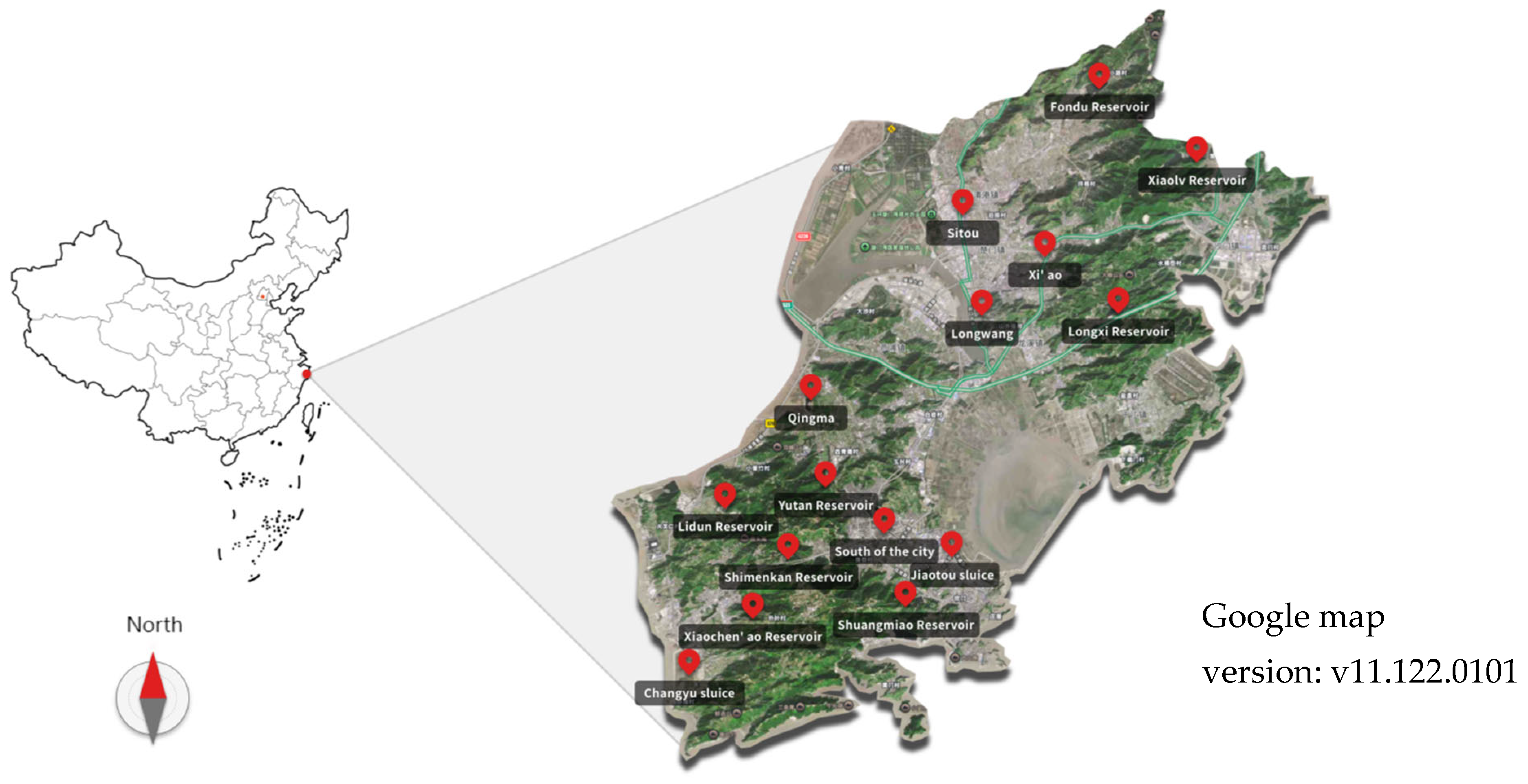
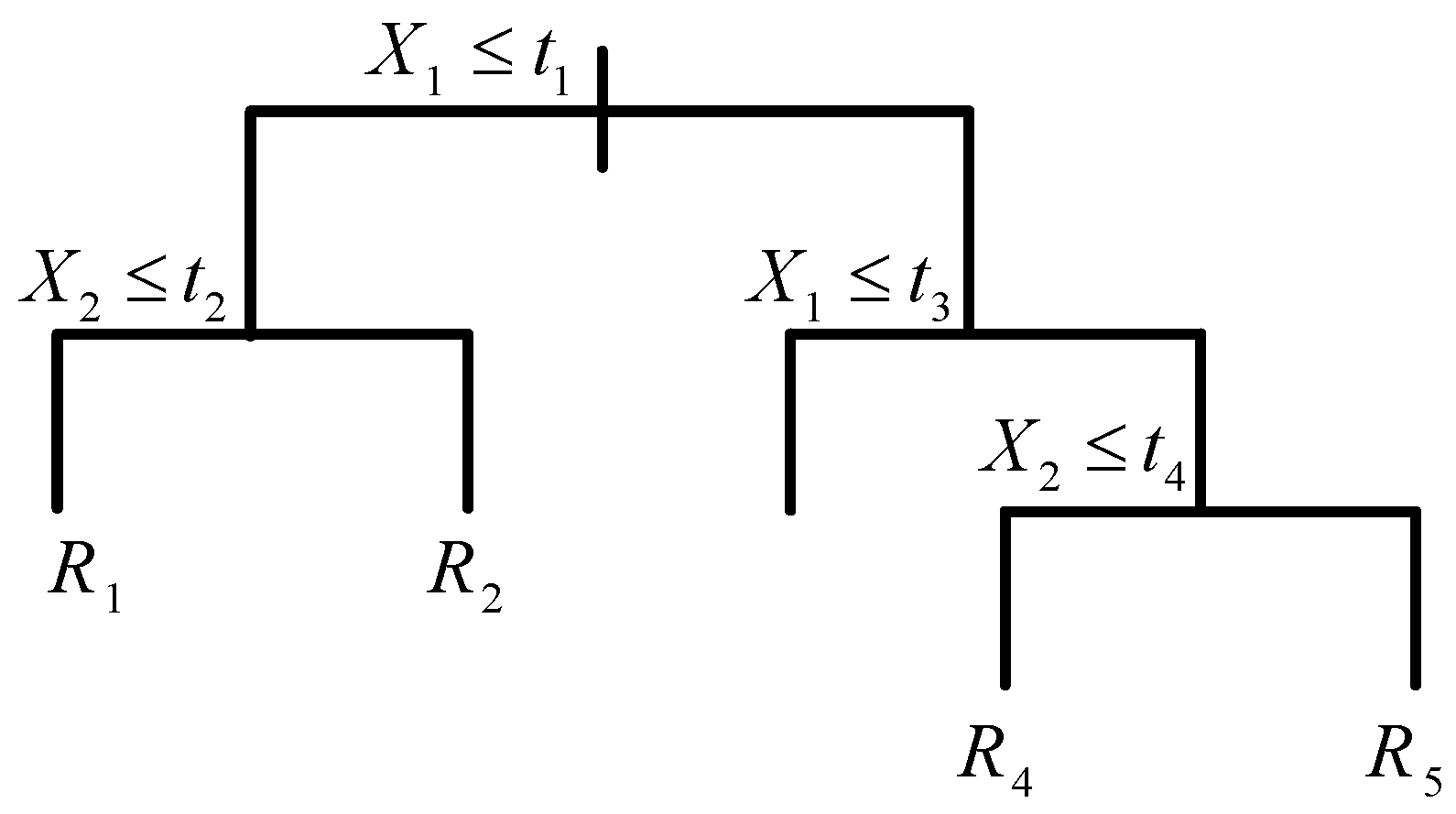


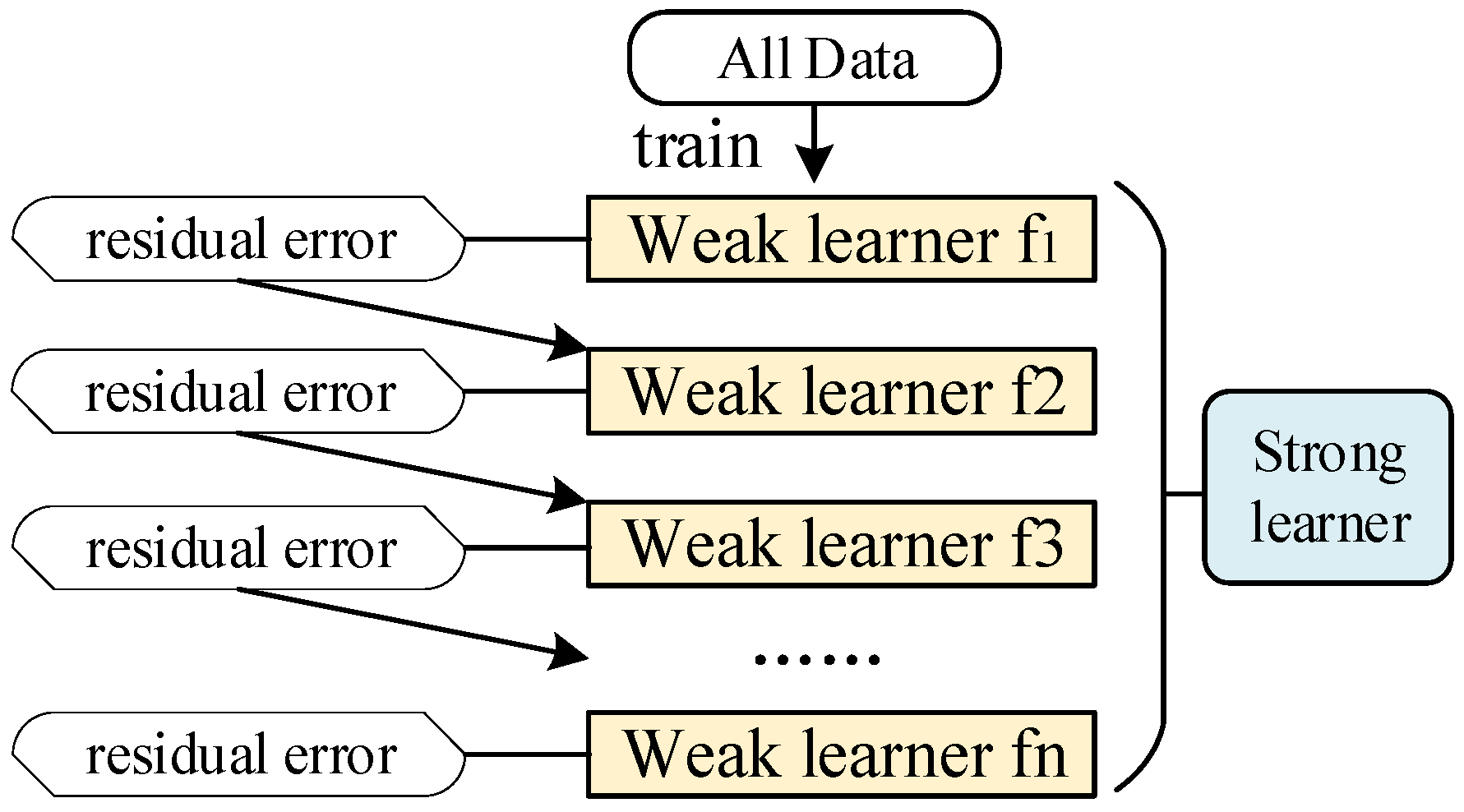
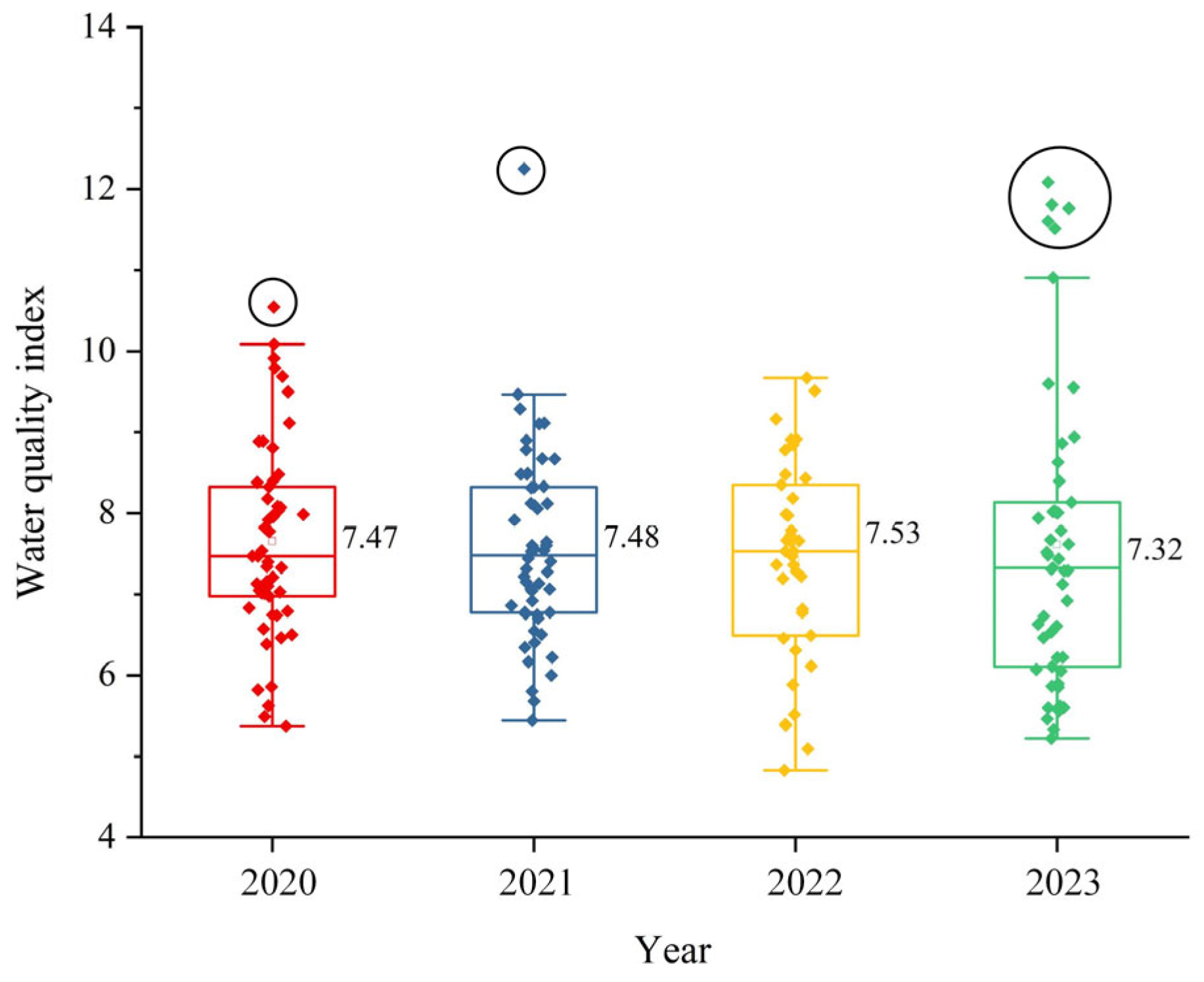

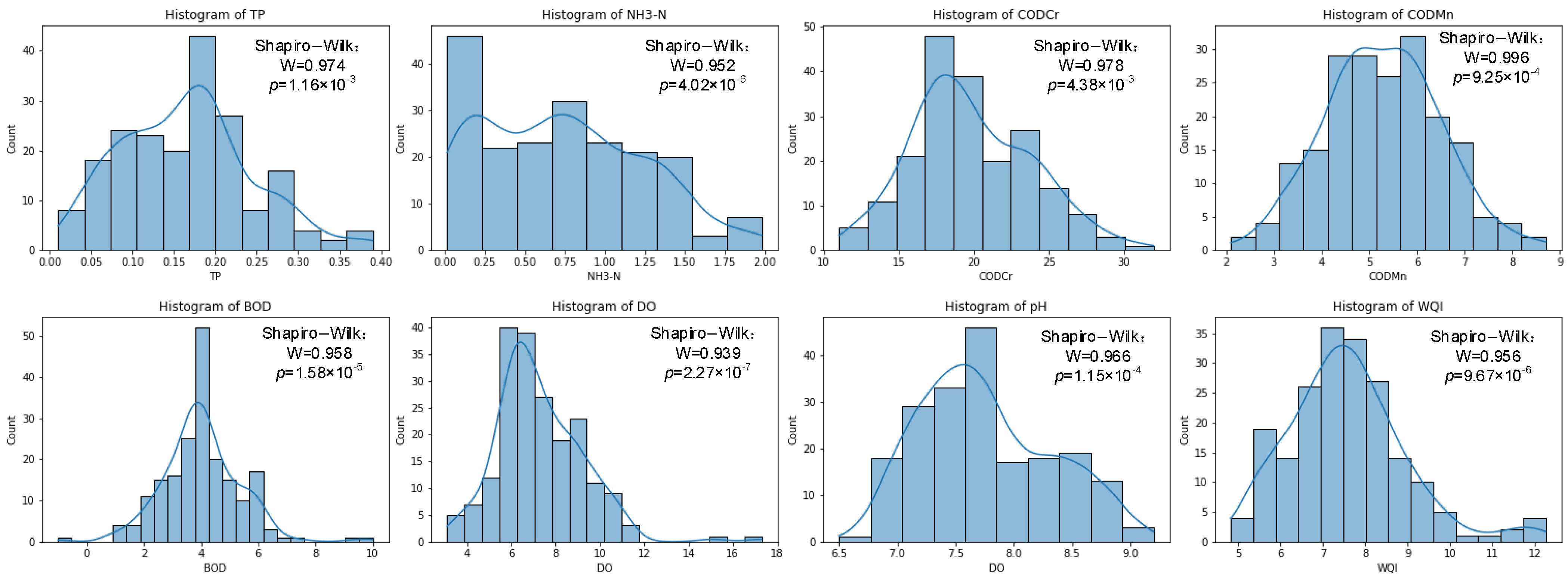
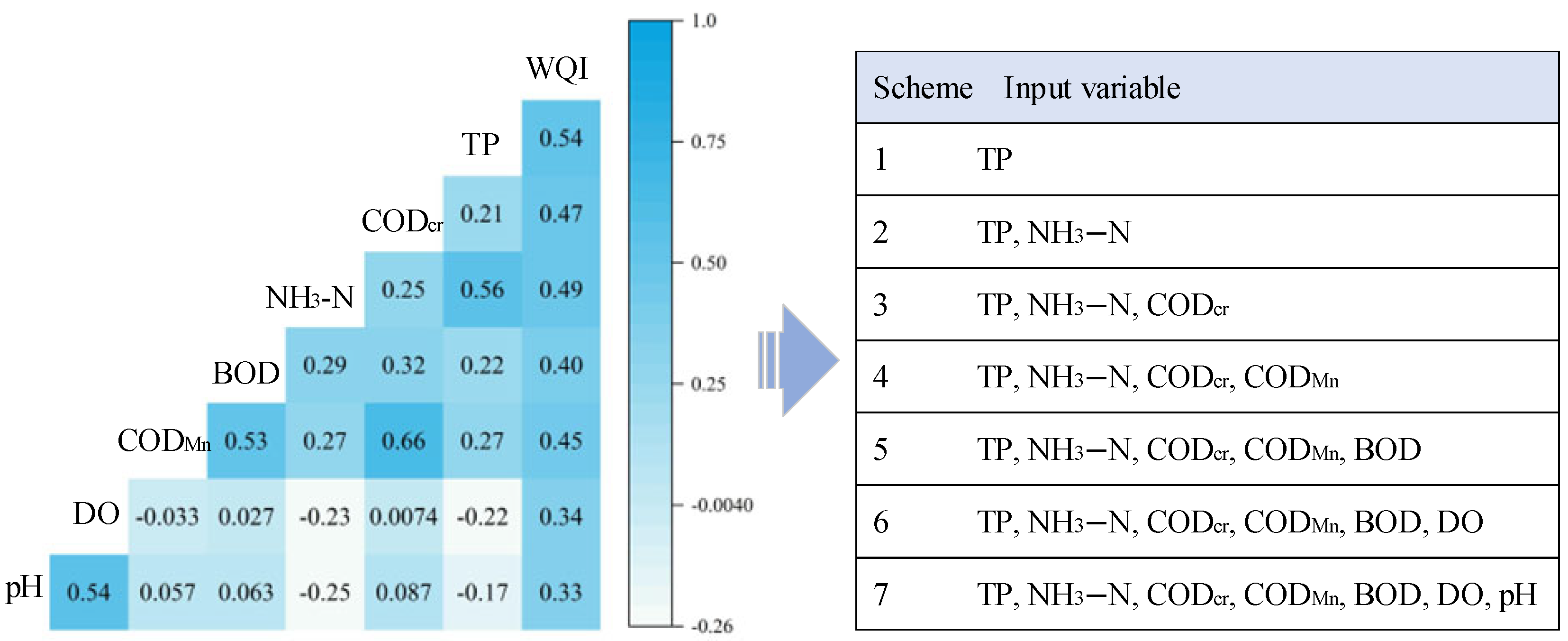
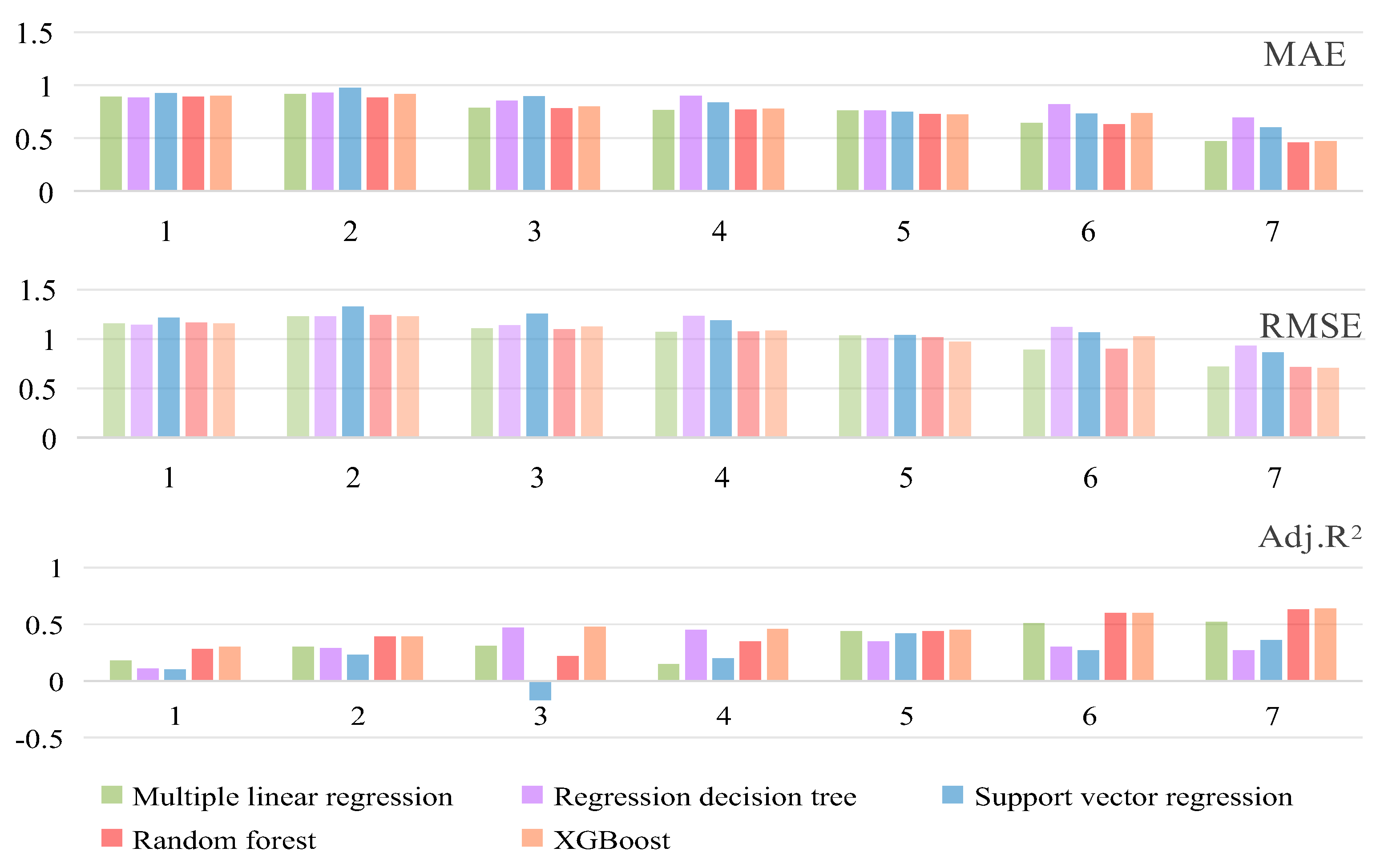
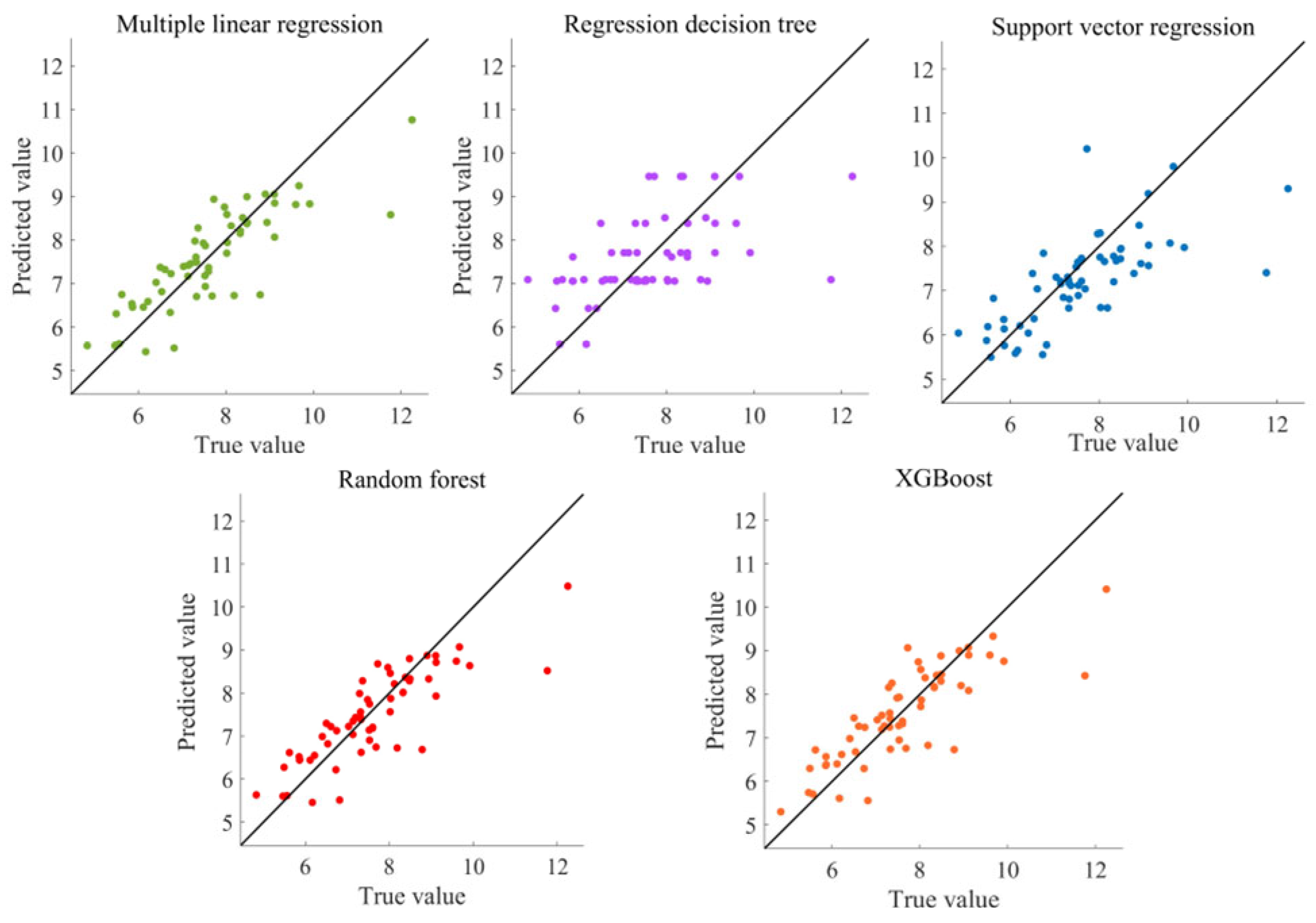

| Water Quality Parameters | I | II | III | IV | V |
|---|---|---|---|---|---|
| BOD | 0 | 15.73 | 58.37 | 25.88 | 0 |
| CODcr | 10.09 | 10.09 | 46.78 | 33.02 | 0.45 |
| CODMn | 0 | 15.74 | 58.38 | 25.88 | 0 |
| DO | 43.47 | 37.19 | 13.04 | 6.28 | 0 |
| NH3-N | 2.11 | 34.39 | 38.09 | 25.3 | 5.29 |
| TP | 1.52 | 23.85 | 51.77 | 18.78 | 4.06 |
| Models | Parameters Tuning | The Best Parameters |
|---|---|---|
| Multiple linear regression | / | / |
| DT | max_depth = [None, 5, 10] | max_depth = [None] |
| min_samples_split = [2, 10, 15, 20] | min_samples_split = [15] | |
| min_samples_leaf = [1, 2, 4] | min_samples_leaf = [2] | |
| SVR | C = [1, 10, 100] | C = [100] |
| gamma = [’scale’, ’auto’, 10, 100] | gamma = [’scale’] | |
| kernel = [’linear’, ’rbf’, ’poly’] | kernel = [’linear’] | |
| RF | n_estimators = [30, 50, 100] | n_estimators = [30] |
| min_samples_split = [2, 5, 10] | min_samples_split = [2] | |
| min_samples_leaf = [1, 2, 4] | min_samples_leaf = [1] | |
| XGBoost | n_estimators = [100, 150, 200, 250] | n_estimators = [200] |
| max_depth = [3, 5, 7, 9, 11] | max_depth = [7] | |
| learning_rate = [0.01, 0.1, 0.2, 0.3] | learning_rate = [0.1] |
Disclaimer/Publisher’s Note: The statements, opinions and data contained in all publications are solely those of the individual author(s) and contributor(s) and not of MDPI and/or the editor(s). MDPI and/or the editor(s) disclaim responsibility for any injury to people or property resulting from any ideas, methods, instructions or products referred to in the content. |
© 2025 by the authors. Licensee MDPI, Basel, Switzerland. This article is an open access article distributed under the terms and conditions of the Creative Commons Attribution (CC BY) license (https://creativecommons.org/licenses/by/4.0/).
Share and Cite
Zhang, C.; Wang, L.; Lin, C.; Lu, M. Prediction of Water Quality Index of Island Counties Under River Length System—A Case Study of Yuhuan City. J. Mar. Sci. Eng. 2025, 13, 539. https://doi.org/10.3390/jmse13030539
Zhang C, Wang L, Lin C, Lu M. Prediction of Water Quality Index of Island Counties Under River Length System—A Case Study of Yuhuan City. Journal of Marine Science and Engineering. 2025; 13(3):539. https://doi.org/10.3390/jmse13030539
Chicago/Turabian StyleZhang, Cheng, Lei Wang, Chuan Lin, and Minyuan Lu. 2025. "Prediction of Water Quality Index of Island Counties Under River Length System—A Case Study of Yuhuan City" Journal of Marine Science and Engineering 13, no. 3: 539. https://doi.org/10.3390/jmse13030539
APA StyleZhang, C., Wang, L., Lin, C., & Lu, M. (2025). Prediction of Water Quality Index of Island Counties Under River Length System—A Case Study of Yuhuan City. Journal of Marine Science and Engineering, 13(3), 539. https://doi.org/10.3390/jmse13030539






